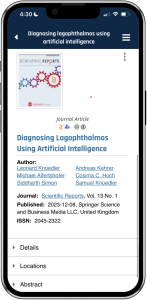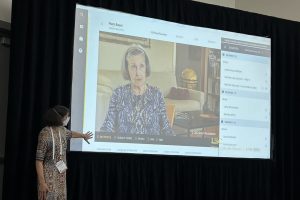
As more academic journals adopt an open access (OA) approach to publishing, more high-quality research is available for free—and public libraries are well poised to help their patrons and their communities benefit. Below are five things every public library should know about how and why OA content can be useful.
1. OA helps combat social media misinformation and bias.
Social media is the most popular news source for American millennials, with more than 43% of TikTok users reporting daily news consumption from that app alone. Thanks to social algorithms, information is easier to find than ever before, and it often comes with the bias and perspective of its creators. Meanwhile, well-researched, neutral information is hidden behind paywalls or subscriptions. For those who are looking for trustworthy reporting, OA resources can help fill the void, providing vital, peer-reviewed information about health and science, climate change, political and social issues, and other essential topics.
2. OA research and open educational resources (OER) can counter income inequality by helping to level the playing field.
Nearly all libraries with formal equity, diversity, and inclusion goals consider collection management as a major part of their efforts. OA and OER can help libraries serve underprivileged demographics and showcase a greater diversity of voices in their electronic collections.
OER supports learners of all ages. Sixty percent of city libraries offer adult education and literacy programs, while nearly 40% of them offer college or trade preparation programs for teenagers. Being able to easily access OER can help libraries better serve these populations.
It was the easy availability of OER content that attracted Jim Benson to CloudSource OA. Benson, library systems and applications analyst for Cleveland Public Library–based library consortium CLEVNET, says, “For a lot of our member libraries, their service area is associated with a school district.” Those libraries can draw on CloudSource OA, he points out, “for things like lesson plans or problem examples. You can narrow down searches using the format filter for OER.”
3. Open access can help in times of shrinking library budgets.
Under traditional publishing models, libraries must pay substantial amounts to access high-quality journals and other periodicals. As just one example, Duke University Libraries in Durham, North Carolina, has calculated that it pays the same amount for one year of access to a package of online journals published by Elsevier as it would for a 100-acre private island in the Bahamas.
 However, libraries don’t need to spend the cost of a private island when 60% of all scholarly articles published in 2023 were published with an OA license. Unlike traditional databases, which require libraries to subscribe to expensive journals to reveal OA content, CloudSource OA—the OA-forward discovery platform from SirsiDynix—offers 60 million resources, including articles, books, and open educational resources, and that number is growing each year. With CloudSource OA, libraries can stay current in their research and educational offerings while stretching budgets for crucial paid subscriptions.
However, libraries don’t need to spend the cost of a private island when 60% of all scholarly articles published in 2023 were published with an OA license. Unlike traditional databases, which require libraries to subscribe to expensive journals to reveal OA content, CloudSource OA—the OA-forward discovery platform from SirsiDynix—offers 60 million resources, including articles, books, and open educational resources, and that number is growing each year. With CloudSource OA, libraries can stay current in their research and educational offerings while stretching budgets for crucial paid subscriptions.
In addition, CloudSource OA’s ease of use means that library staff time is freed up as well. In a time when staffing is the top challenge limiting libraries’ program and service offerings, a product that needs little staff attention to set up or use is particularly valuable. Not only is CloudSource OA administration easy on staff, but patrons will find the search interface intuitive to use as well.
“There wasn’t much of a learning curve,” says Missy Williams, head of virtual reference services for the Delaware Division of Libraries, where CloudSource OA is embedded in the catalog. “I like that it is one-click. You search for something, and you can just click on ‘view resource’ and it takes you right to it.”
4. Open access resources are more than just journal articles, and not all of them are included in the DOAJ.
While many libraries already provide access to Directory of Open Access Journals (DOAJ) through their discovery layer, it’s important to understand that resources available through DOAJ represent only about 16% of open access scholarly journals—only fully-open gold and diamond journals. The other 84% of OA resources are like an iceberg below the ocean surface: massive in scope but hard to see. These resources include hybrid journals (where open articles are published alongside paywalled articles), ebooks, e-textbooks, audiovisual material, and OER. Libraries who provide access to the DOAJ alone are missing out on 84% of this rich OA content.
Further, more than 40% of public libraries offer programs or classes for homeschooling families, yet DOAJ does not contain OER such as e-textbooks, lesson plans, or tutorials. For that kind of valuable content, users must look elsewhere. CloudSource OA not only aggregates OER content, but it also provides helpful filters to identify resources appropriate for different audiences, age groups, and purposes.
5. CloudSource OA helps surface relevant search results.
Like internet searches and social media, CloudSource OA is easy to use and yields a plethora of results. Unlike internet searches and social media, CloudSource OA surfaces uniformly reliable, high-quality information—without ads or promoted content.
Patrons don’t have to be tech-savvy to use CloudSource OA, nor do librarians have to invest much time teaching it. Even for users without a library card, CloudSource OA provides one-click access to full-text articles—no login or authentication required. “It’s just there and it works,” Benson says. “It’s maintenance-free for us.”
Other advantages of the platform include both advanced and natural-language searching; metadata enhancements like citation tools, web reviews, and author information and affiliations; and research helpers such as the ability to search within results.
Finding information is hard. Finding vetted and trustworthy information is harder. Even information professionals sometimes struggle with the commodification and polarization of the internet and social media platforms, which present ads as news and serve up information based on hidden algorithms. With trustworthy resources, an intuitive search interface, and one-click access—with no need to remember a login or library barcode—CloudSource OA can simplify this process for both patrons and librarians.
For more information, visit CloudSource.net to request a demo or a free collection analysis to see how much of your current collection is OA.



